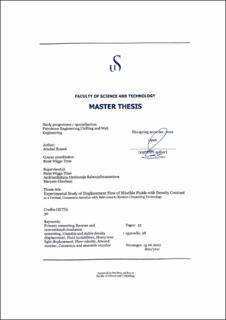| dc.description.abstract | The primary cement job is an essential and complex operation in the oil and gas industry which is performed to support the casing, build a well barrier, and produce an isolated zone. Complete displacement of the drilling mud by cement without any contamination is critical for the productivity life of the well. The primary cementing consists of two methods. First is the conventional method, in which cement is pumped into the casing and turned back through the annulus. The second is the reverse method, in which cement is pumped into the annulus and back through the pipe, especially recommended for fractured zones and circulation loss problems. In recent years, there have been several studies related to the conventional cementing job, which is stable displacement. However, insufficient knowledge about the heavy-over light fluid displacement in reverse cementing prevents further improvement in the primary cementing process.
In this work, an experimental setup for reverse and conventional circulation in an annulus has been built and designed. Moreover, the unstable-density-displacement of two miscible fluids has been studied. Both fluids are Newtonian and low viscous. The main focus is studying the effect of flow velocities and density ratio between displaced and displacing fluids on displacement time and front velocity. More than 100 experimental runs have been done to analyze the different parameters. Water is considered as the light fluid, and for heavy fluid, salt (NaCl) is used as a weighting agent to increase and change the density of water. The heavy fluid is placed above the lighter fluid. Two fluids are initially separated by a ball valve. Also, an outlet valve is considered to regulate the flow velocity. The experimental runs are performed at Atwood numbers of 0.003 and 0.02 and flow velocities of 0, 12, 25, and 33 mm/s. Also, stable-density displacement has been studied for the Atwood number of zero ( iso-dense fluids) and 0.02 to compare with unstable-density displacement. The fluid displacement is recorded by a camera, and videos are converted to images by a Python script. The spatiotemporal diagram is used to show the extension and development of the fluid mixing zone. The investigation of fluid displacement at different density ratios shows that there is a strong tendency to backflow and transverse flow for all unstable-density displacements. Also, the front velocity and mixing zone are increased with rising density instability. It is observed that the flow velocity and density difference affect the degree of instabilities. By increasing the imposed velocity, the backflow is suppressed, and the Atwood number's effect is weakened. Compared to unstable-density displacements, there is no backflow and transverse flow in stable-density displacement, and the displacing and displaced fluids are separated by a sharp interface. Although this interface is less clear for iso-dense displacement compared to the Atwood number of 0.02, the flow displacement is still uniform. | |
